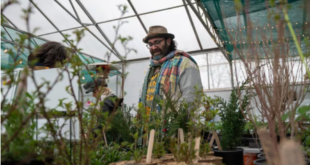Coyotes are more likely to be out during the day during January and February as they seek to mate.

It’s mating season for coyotes, which means they’re more likely to be out and about during the day.
With that in mind, the City of Burlington, Ont., is reminding residents what to do if they encounter one, and how to coyote-proof their properties.
Last week, the city also updated its bylaws to let wildlife management professionals use firearms but the city’s head of bylaw says that’s not to make it easier to kill coyotes but makes the response require less staffing.
“Coyotes have always been here. People just didn’t notice them,” Kerry Davren, Burlington’s director of bylaw compliance told CBC Hamilton.
Coyote concerns grew in 2022
Male coyotes weigh nine to 23 kilograms, and grow 58- to 66-centimetres-tall, the Canadian Wildlife Federation says. Females are about 20 per cent smaller.
The creatures primarily hunt rabbits and rodents, but are also known to scavenge and hunt livestock. They can be found throughout Canada.
In 2022, a spate of seven coyote attacks injured a few residents, alarmed the wider community and led the city to kill several coyotes it deemed responsible for attacks on people or found to be acting aggressively. Eventually, officials blamed the rise in coyote aggression on people feeding the animals.

Davren says the city saw people leaving out waste that attracted rodents coyotes prey on. It also found people were deliberately leaving food out for the canines in parks and long trails. That, she said, coupled with more people being at home due to the pandemic, meant more opportunity for human-animal conflict.
The city notes feeding wildlife can result in a fine.
How to make your yard less attractive for coyotes
This past year hasn’t seen as much conflict as in 2022, Davren said, so a bylaw priority is to continue to educate residents.
“This is about educating people so that they understand … this happened because of the way we’re behaving. It’s not about the coyotes themselves.”
The city is offering educational sessions on coyotes at the Burlington Central Library, the next of which is on Feb. 22, and residents can request animal control staff audit their yard for things that may attract coyotes.
To prevent coyote conflicts, the Ministry of Natural Resources and Forestry recommends people:
- put up fences in their yards;
- store garbage in places coyotes cannot access;
- clean up after pets; and
- remove food sources, among other things.
If people do encounter coyotes, it recommends keeping distant, making noise and slowly backing away — never running or turning one’s back. The province says people should report coyote conflicts to their municipalities, many of which also track coyote sightings.
Burlington bylaw change
The bylaw change in Burlington will also help, the city said.
It was made to enable wildlife management professionals to use guns after the city realized it had not formally exempted them from rules prohibiting firearm usage.
Davren said that meant the city had to send animal control bylaw officers out with wildlife management specialists should they wish to “take action” against a coyote, an unnecessary duplication.
Wildlife control specialists offer a range of services including tracking and deterring wild animals, and often partner with municipalities. Davren added that the change will also make it simpler for farmers to contract such services if, for example, coyotes are preying on their wildlife.
Davren emphasizes that this was legal “housekeeping,” not a change in enforcement. “We don’t have people running around killing coyotes in the city.”
Per the city’s coyote strategy, Burlington only seeks to kill coyotes that have bitten people. Wildlife management professionals must still have the proper training and documentation to use guns, work with the city, and alert police of their activities, Davren said.

Understanding coyotes is key: wildlife control specialist
Wildlife-control specialist Michael von Kaitz says businesses like his, The Wildlife Management Group Inc., only kill coyotes or other animals as a last resort.
In fact, von Kaitz said he can’t recall the last time his company killed an animal for any reason other than it being “too ill to survive.”
Management is not a “wild west approach,” and begins with understanding animal behaviour, he said.
Von Kaitz’s Burlington-based business mainly operates in southern Ontario and works with municipalities to control species including geese and coyotes. It’s worked with Burlington on coyote management since early 2023, he said.
Professional coyote management involves modifying habitats and deterring the animals with tools such as cougar scat and wolf urine, which smell like their predators, he said. It also means verifying reported sightings by tracking coyotes and monitoring what they’re doing and eating.
Often, von Kaitz said, a coyote will move on after showing aggression toward humans, and no longer be a problem.
Coyotes are opportunistic and will take advantage of existing features in their environment to make breeding and hunting dens, such as yard waste people dump, he said. And while they tend to stick to green spaces, they will come close to people for food in the right circumstances.
That’s why it’s so important not to feed them, von Kaitz said. “The last thing you want to do is have old coyotes teach new coyotes how to survive in [an urban] habitat.”
If coyotes start feeding on domestic animals or livestock, or displaying aggression toward people, wildlife specialists will act on cities’ orders to shoot them, he said, pointing to a saying he said he learned from the province: “A fed coyote is a dead coyote.”
ABOUT THE AUTHOR

Reporter
Justin Chandler is CBC News reporter in Hamilton. He covers all sorts of stories but has a special interest in how public policy affects people. Justin covered current affairs in Hamilton and Niagara for TVO, and has worked on a variety of CBC teams and programs, including As It Happens, Day 6 and CBC Music. He co-hosted Radio Free Krypton on Met Radio. You can email story ideas to justin.chandler(at)cbc(dot)ca.
*****
Credit belongs to : www.cbc.ca
 Atin Ito First Filipino Community Newspaper in Ontario
Atin Ito First Filipino Community Newspaper in Ontario






